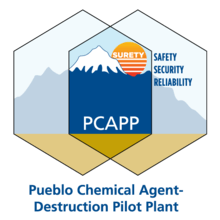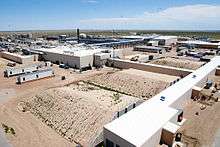Pueblo Chemical Agent-Destruction Pilot Plant


The Pueblo Chemical Agent-Destruction Pilot Plant (PCAPP) is a chemical weapons destruction facility that has been built to destroy the chemical weapons stockpile at the Pueblo Chemical Depot, in southeastern Colorado. The depot contains munitions containing 2,611 tons of mustard agent that are part of the U.S. national chemical weapons stockpile. The weapons have been stored at the 23,000-acre (93 km2) depot since the 1950s.
Destruction of this stockpile is a requirement of the Chemical Weapons Convention, an international treaty to which the United States is a party. The Organisation for the Prohibition of Chemical Weapons is the implementing body of the Chemical Weapons Convention and monitors the progress of the nation's chemical weapons destruction programs.
The Program Executive Office, Assembled Chemical Weapons Alternatives (PEO ACWA) oversees the destruction of the Pueblo chemical weapons stockpile.
Bechtel Pueblo Team (BPT; consisting of Bechtel National, Inc., URS and Battelle Memorial Institute) will design, construct, pilot test, operate and close PCAPP.
Planning of activities
After systemization of the facility, destruction operations are expected to begin in 2016 and to be complete by 2019.[1] The plant will operate until all the chemical weapons have been destroyed. Closure activities (shut-down, dismantling, and restoration of site) are slated to be completed by 2022.
In 2010, the Pueblo Chemical Depot, in conjunction with the ACWA program, completed an environmental assessment (EA) to meet the requirements of the National Environmental Policy Act, or NEPA, and Title 32 Code of Federal Regulations Part 651[2] regarding the construction and operation of the U.S. Army’s Explosive Destruction System (EDS) and/or other explosive destruction technologies (EDT), at the U.S. Army Pueblo Chemical Depot in Colorado.[3] The EA was withdrawn and a new EA was completed in 2012.[4] The new EA focused on the use of EDT for destroying overpacked and reject munitions.[5] In April 2013, Program Executive Officer Conrad F. Whyne announced his selection of EDS to augment the Pueblo Chemical Agent-Destruction Pilot Plant for the safe destruction of chemical munitions unsuited for processing by the main plant’s automated equipment.[6]
History of chemical demilitarization in Colorado
| Decade | Milestones |
|---|---|
| 1950s[7] |
|
| 1980s[8] |
|
| 1990s[9] |
|
| 2000s |
|
| 2010s |
|
Technology
The Department of Defense conducted studies[16] to evaluate potential impacts of the elimination of these weapons using incineration and non-incineration methods. Four technologies were considered:
- incineration
- chemical neutralization followed by supercritical water oxidation
- chemical neutralization followed by supercritical water oxidation and gas phase chemical reduction
- electrochemical oxidation
Neutralization followed by biotreatment was selected for the destruction of the Colorado stockpile.
The technology comprises the following steps:[17]
- Robotic equipment removes energetics (explosives) from the weapon, including the fuze and the burster. The energetics are disposed of at a permitted facility off site.
- The inside of the weapon is remotely accessed and mustard agent is washed out with high-pressure water.
- The mustard agent is mixed with hot water. The resulting mixture is neutralized with a caustic solution. The byproduct is called hydrolysate. The hydrolysate is treated biologically.
- The water is recovered for reuse in the destruction process and the excess activated sludge is secured in containers for disposal at an off-site permitted facility.
- Metal parts are heated to 1,000 °F (538 °C) for 15 minutes and are then recycled.
Explosive Destruction Technology (EDT)
After an assessment of problem munitions showed that their destruction would be difficult using neutralization and biotreatment, ACWA decided to explore use of Explosive Destruction Technology (aka Explosive Demolition Technology, Explosive Detonation Technology, EDT) for these projectiles.
EDT uses heat and pressure from explosion or just heat to destroy the munitions; it is not considered incineration and does not require disassembly of the weapons.[18] There are three general types of technologies that can destroy chemical weapons:
- Detonation technology – destroys the majority of the agent and explosive in the munition by detonating donor explosives wrapped around the munition. The resulting off-gasses are processed through secondary treatment to ensure agent destruction. Examples of detonation technology include the Transportable Detonation Chamber, or TDC, and the DAVINCH (Detonation of Ammunition in a Vacuum-Integrated Chamber).
- Neutralization technology – uses small explosive shaped charges to open the munition and consume the explosive in the burster and fuze. The agent is destroyed by subsequent neutralization. The U.S. Army’s EDS, is an example.
- Thermal destruction – uses the heat of the electrically heated containment vessel to deflagrate the munition and destroy the agent and energetics. The resulting gases are treated in an off-gas treatment system. The Static Detonation Chamber, or SDC, is an example of thermal destruction technology.
In April 2013, Program Executive Officer Conrad F. Whyne announced his selection of the U.S. Army’s EDS to augment the PCAPP for the safe destruction of chemical munitions unsuited for processing by the main plant’s automated equipment.[6]
The PCAPP EDS started processing on March 18 with the elimination of Department of Transportation (DOT) bottles which contain chemical agent drained from selected munitions over the years to assess the condition of the stockpile. On April 8, the first munitions were successfully processed. In June, operators at the PCAPP EDS took things up a notch with the introduction of 4.2-inch mortars into the destruction process. The first three mortars were joined by three 105 mm projectiles. All were safely detonated in the vessel on June 18. On July 16, the first 155 mm projectiles from Pueblo’s stockpile were safely destroyed in the PCAPP EDS. The PCAPP EDS completed its first campaign in February 2016, destroying 549 munitions that leaked or were sampled in the past and 11 bottles containing mustard agent. It will remain on stand-by to destroy any munitions rejected for automated processing in the main plant due to their condition.[14]
Public outreach
The Pueblo Chemical Stockpile Outreach Office was established in 1997 to serve as the community’s primary information resource on chemical weapons destruction in Colorado. The office responds to inquiries, provides information materials and coordinates guest speakers for a variety of different civic groups and organizations and interfaces with the governor-appointed Colorado Chemical Demilitarization Citizens’ Advisory Commission.
See also
References
- ↑ http://www.peoacwa.army.mil/media-toolkit/press-releases/dod-approves-new-cost/
- ↑ assessment for meeting the requirements of the National Environmental Policy Act, or NEPA, and Title 32 Code of Federal Regulations Part 651
- ↑ http://www.peoacwa.army.mil/wp-content/uploads/ACWA_News_Release_26Feb10.pdf
- ↑ http://www.peoacwa.army.mil/wp-content/uploads/acwa_edt_press_release13sept10.pdf
- ↑ http://www.peoacwa.army.mil/pcapp/explosive-destruction-technology-edt-at-pcapp/
- 1 2 3 http://www.peoacwa.army.mil/media-toolkit/facts-pages/facts-page-pcapp-explosive-destruction-system-eds/
- ↑ PEO ACWA (3 November 2009). "U.S. Army Pueblo Chemical Depot: Seven Decades of National Defense". Retrieved 17 July 2016 – via YouTube.
- ↑ http://www.peoacwa.army.mil/media-toolkit/facts-pages/peo-acwa-legislation/
- 1 2 3 http://www.peoacwa.army.mil/about-peo-acwa/program-timeline/
- ↑ http://www.peoacwa.army.mil/pcapp/
- ↑ "Chevron's Waste Water Treatment Technology Acquired - Bechtel". Retrieved 17 July 2016.
- ↑ http://www.peoacwa.army.mil/media-toolkit/press-releases/pueblo-chemical-agent-destruction-pilot-plant-receives-national-safety-recognition/
- ↑ "Pueblo Chemical Depot explosives unit finishes job; main operation to begin soon". Retrieved 17 July 2016.
- 1 2 KRDO. "560 shells, bottles of mustard agent destroyed in Colorado". Retrieved 17 July 2016.
- ↑ http://www.military.com/daily-news/2016/09/08/army-begins-destroying-chemical-weapons-colorado.html
- ↑ Council, National Research (16 August 2006). "Review and Assessment of the Proposals for Design and Operation of Designated Chemical Agent Destruction Pilot Plants (DCAPP-Pueblo): Letter Report". doi:10.17226/11714. Retrieved 17 July 2016.
- ↑ http://www.peoacwa.army.mil/pcapp/pcapp-destruction-technology/
- ↑ http://www.peoacwa.army.mil/media-toolkit/facts-pages/edt/
- "Program Executive Office, Assembled Chemical Weapons Alternatives Website". Department of Defense; Program Executive Office, Assembled Chemical Weapons Alternatives. Retrieved 2009-06-01.
![]() This article incorporates public domain material from the United States Government document "".
This article incorporates public domain material from the United States Government document "".
External links
- Centers for Disease Control - Chemical Demilitarization
- Chemical Stockpile Emergency Preparedness Program
- Pueblo County Sheriff’s Office CSEPP
- http://www.cdphe.state.co.us/hm/pcdcac.htm
- http://www.defenselink.mil/
- U.S. Department of Health and Human Services
- Federal Emergency Management Agency
- U.S. Army Chemical Materials Activity
38°21′N 104°19′W / 38.35°N 104.31°W